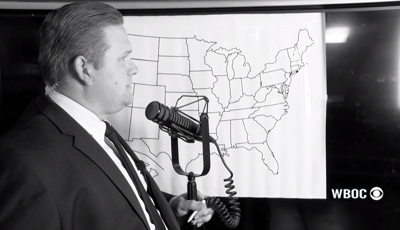Meteorologist Mike Lichniak shows us back in 1954 the national weather service was the backbone of the forecast each night.
As WBOC-TV celebrates its 70th anniversary, it's a fitting time to reflect on the evolution of weather forecasting and the significant changes witnessed over the decades. From humble beginnings relying on basic tools to the sophisticated technology at our disposal today, the journey of weather presentation has been nothing short of remarkable.
In the early days of television weather reporting, back in 1954, the National Weather Service stood as the primary source of weather forecasts each night.
Back then, weather forecasts were a far cry from the detailed and real-time updates we enjoy today. Before the advent of modern technology, meteorologists relied on rudimentary tools and manual data collection methods. Radar systems, for instance, didn't make their debut until 1959, thanks to donations from the military post-World War II.
Eric Seymore of the National Weather Service recalls a time when weather data was obtained through teletype, with observations taken at airports and transmitted manually. This painstaking process meant forecasts were limited in accuracy and scope, typically only extending a day out, if that.
In the early 1950s, weather presenters, rather than meteorologists, delivered forecasts. These presenters would communicate with meteorologists at the Weather Bureau to obtain the day's weather map details. The interaction was often broadcasted live, adding an element of spontaneity to the presentation.
Fast forward to today, and the landscape of weather forecasting has been revolutionized. Advanced technologies such as radar, satellite imaging, and computer models provide meteorologists with unprecedented insights into weather patterns. With the WBOC Weather App, sponsored by Hertrich, viewers can access up-to-the-minute forecasts with ease, reflecting the integration of technology into our daily lives.
Moreover, the deployment of weather satellites has played a pivotal role in enhancing our understanding of weather systems. From the first satellite launched in 1960, which transmitted images intermittently, to the current GOES satellites sending high-resolution images every minute, the progress is astounding. Now, anyone can access these images the moment they are sent back to Earth, empowering individuals with valuable information for planning and decision-making.
As we celebrate seven decades of WBOC-TV, it's clear that while the methods of weather forecasting have evolved dramatically, one thing remains constant: the unpredictable nature of Delmarva weather. So, if you find yourself dissatisfied with the forecast, just remember, on Delmarva, weather changes are as inevitable as they are unpredictable.


